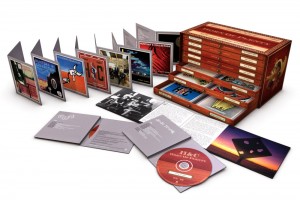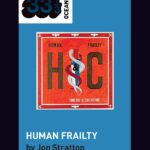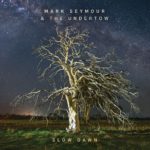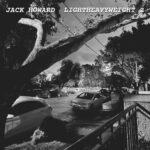Hunters and Collectors – Horn of Plenty
![]()
Comprehensive, definitive Hunters and Collectors box set.
Released In: [Australia / NZ].
Release Date: 22 November 2008.
Australian Chart Position: [Did Not Enter].
Availability: Moderately common. Available new in CD/DVD format.
Value: A$80-A$200.
Legend:
![]() Commercial single.
Commercial single.
![]() Promotional single.
Promotional single.
Version: Liberation Records Australian CD/DVD box set.
Total box set length: 14 CD’s, 2 DVD’s.
ReplayGain loudness: -9.83 (2008).
- Hunters and Collectors
- The Fireman’s Curse
- The Jaws Of Life
- Human Frailty
- What’s A Few Men?
- Ghost Nation
- Cut
- Demon Flower
- Juggernaut
- Mutations
- Living In Large Rooms & Lounges CD1
- Living In Large Rooms & Lounges CD2
- Cargo Cult (Three X E.P.)
- Spare Parts
- Under One Roof + The Way To Go Out DVD
- Natural Selection DVD
All CD’s and DVD’s are remastered. The DVD’s have no region code and are in the PAL format.
The track listings of the standard studio albums included vary slightly from the normal Liberation Records remasters. The Cargo Cult (Three X EPs) disc includes the World of Stone, Payload and Living Daylight EP’s. In turn, the version here of Hunters and Collectors does not include World of Stone, The Jaws of Life does not include Payload and Human Frailty does not include Living Daylight.
Box sets do not get any better than Horn of Plenty.
Robert Miles (Hunters and Collectors live sound, artwork) went to extraordinarily lengths on this project. The detailed design, contents and art work were his work. Mark Seymour notes:
It has to be said, Rob Miles has really gone out on a limb on this one… the art work is breathtaking. He’s an obsessive bastard at the best of times which is why he’s such a good mixer… but this art work on the boxed set, well, it’s something else.. he spent weeks on it… toiling over a drawing board with a a box of pencils and a rubber… he even shut down a couple of building sites where his architectural work was in progress just so he could finish the job…
Thanks Rob!
Thankyou to Chris Johnston of The Age for allowing us to reproduce his excellent essay that features in Horn of Plenty on True Believers.
THE best place to start is on the road. It’s a code, meaning something other than what it is: “…trucks and beers and memories…”
Begin with an empty map of Australia. Pin it up on the back of a door. Then begin tracing the lines of your journeys onto it. Everything you know about life is there. Speed, violence, love, longing, nationhood. They’re songlines. Faultlines. Then eventually there’s no more map, nowhere else to go. At which point you know you have arrived.
The hard road is made of rock. There’s the sound of an engine now, a rumble big enough to break things down. Truck drivers out here on the edge live in hope and fear. These are the men who wear singlets and love their lonely children, hard men in shorts smelling flammable and dangerous. They hold secrets about where they’ve been and where they might one day go in their giant semi-trailer road trains which can cure but can also kill in the blink of a sunstroked eye.
Cry for your mother, cry for your father and drive on. Sing your tough songs as clouds gather blue. Speed toward the pinpoint horizon.
There’s road kill around, dead things. Wrecks. Gunshots in yellow signs. Sweat, roos and laughter under burning sun. Adelaide is 828 kilometres from the Westgate. That’s Australia out your window.
HUNTERS and Collectors fetishised the road. It held arcane codes for them, but it also held firm logic – it took them to the people who wanted to hear them play.
They were a rock ‘n’ roll band from Melbourne between 1981 and 1998 who did nine studio albums, three live records and three EPs. The band’s life spanned Bob Hawke, the new one-dollar coin, Crocodile Dundee, Keating and Kennett, Mabo & Wik and the beginnings of John Howard. The country prospered, recessed and then matured. It was also an era of great Australian music: Midnight Oil, the Angels, X, INXS and Paul Kelly. Mental as Anything. The Hoodoo Gurus, who formed in the same year.
But Hunters and Collectors had something else, right? Something extra. Some aspect or other. Hindsight is only now beginning to show us a few things about why they were perhaps the most powerfully Australian band of all, the Hunnas, expressing a genuine Australian sensibility and set of ideals.
Mostly, probably, it was to do with their utilitarian ways. Sometimes you got the sense that their instruments were actually tools and they had come to fix or build. The music was prone to fits of violence yet could also be impossibly precise. Vast emotions could be projected. But you got the distinct impression none would ever be wasted.
The shows were intense and definite. At their peak the band could fill every molecule of air in any venue in the country with a noise that was louder and clearer than anyone else. They were an orchestra: simple, strong and powerful yet suspicious of undue ceremony or fanfare. These are very Australian attributes. The trumpet from the famous brass section even played the The Last Post.
But the biggest link they had with this immense, merciless country was the road around it. Discipline and logistics were important, so the road was untroubling. A heightened Australian-ness emerged through their explorations – physical and mental – of the paths they travelled. It was a deep well of subject matter as well as a kind of talisman.
The trucks which took their gear around were integral to the way their minds worked and how their songs sounded because trucks are democratic and infallible. The band’s art came to be defined by the size of that truck. A three tonne show, an eight tonne band, a thirteen tonne tour. These were their charts.
They exerted control over Australia by having it covered. The rhythm of the road settled them. There’s a school of thought now, from the inside, that they didn’t make it huge overseas because the road felt different. It unsettled them. They had adapted perfectly instead to Australian conditions: the tarmac and line, the thirst and furnace of the pubs, the “…trucks and beers and memories…”
THE first anyone knew of this entity was Talking To A Stranger. That was the first proper single, in 1982. And while it wasn’t of the road as such, it did travel right to the perimeter.
It was inspired by a Charles Baudelaire poem called The Albatross in which the French poet imagines bored sailors doing odd, decadent things to a stranded seabird: the first line of both is “…souvent pour s’amuser les hommes d’equipage…” or, “…often to amuse themselves the men of the crew…” The sailors pluck the mystical bird and stick a pipe in its mouth. A baby talks to a stranger; Jesus is a black-eyed female.
It’s taboo and transgressive and about being an outsider. That’s what Baudelaire said as well. That he was stranded amongst imbeciles. The song stands similarly at the precipice looking at a circus of symbols in the beyond too frightened to participate. The album it was from, Hunters and Collectors, was urban-primitive because as well as the dark surrealism of Stranger it also documented a savage, post-industrial aftermath. Things had happened, you sensed that – a scorching, a flattening – and this was the result.
The band bashed on a steel tank – the ‘Wang’, a derelict hot-water cylinder – which was found discarded in blackberries in Melbourne somewhere and recycled into a conceptual and brilliant-sounding musical instrument. It was hit with a glockenspiel key on the two-beat and the four. Around this time the band had a shrunken head – a fetish object – on stage.
The films Mad Max and Mad Max 2 were also part of the Australian cultural uprising then. Mad Max and Hunters and Collectors are both the same kind of red-dirt voodoo concerned with a post-apocalyptic survival instinct, totems and pagan demons, industrial waste, nuclear fallout, feral children, big engines, no petrol and bad, bad animals.
American author Cormac McCarthy wrote a terrifying post-9/11 novel two years ago called The Road. It inhabited the very same space. His people were “refugees shrouded up in their clothing” wearing “masks and goggles, sitting in their rags by the side of the road like ruined aviators.” They were ferals and scavengers, and a sacred, scared father-and-son picking from the bones of mankind, taking shelter in primitiveness after the fall.
They pushed carts up a road because the road was all that was left. Maybe it took them to the sea, maybe not. Their heads were like skulls, their eyes bright in the bone. Skulls, bone, eyes. Dreams and nightmares out there on the perimeter, on the isolated highway. They were “creedless shells of men tottering down the causeways like migrants in a feverland,” McCarthy wrote. “The frailty of everything is revealed at last.”
THE frailty of everything is revealed at last. That’s a line so beautiful and so conclusive that it should have been on Human Frailty, Hunters and Collectors’ fourth album, of 1986.
This is the one that most people would cite as the band’s masterpiece. There is nothing surplus on it, not one note, not one breath. It also broadens many of their central metaphors into an emotional directness about how men and women react to one another – in both a global and personal sense.
The artwork is a modified version of the ancient Greek symbol for medicine, the caduceus, which suggests a certain anatomical correctness, a healing hand. It’s also a rock’n’roll symbol, a tattoo, but rendered in a careful, craftsmanlike way. On the back is a photograph of male and female hands interlocked against a cobalt blue sky, suggesting that even in the harsh light of the Great Southern Land love will save the day.
There is no death-mask, no totem, There is, however, on the accompanyingLiving Daylight EP, a song about mining and men called Inside A Fireball – “…bromide, sulphide, oxide, slag…” – set in old Broken Hill. But it could easily also be set today over West in the open-cut wealth.
The Australian resources boom means a transient workforce, where men from all over go in to work the heavy trucks and graders and flatten the land and dig the biggest holes in the world. Then these men hit the pole-dancer pubs at night in Port Hedland, say, where they’re living for six to eight months earning four grand a week and they have no responsibility to the place. They owe it nothing except their labour.
The whole notion of community vanishes in clouds of dust. There’s people to fix diesel engines but no one to run the local footy club. The love has gone. It’s as if the scars in the ground and the slag visible from the road are nothing but the debris of humanity. A reminder of the fate that befell men and women.
Hunters and Collectors’ tradesmanlike, working class sensibility had emerged; their utilitarian streak. The core of the band formed out of universities, which meant they romanticised the Left and ideas of compassion, welfare and equality. The caduceus implied that. The songs were hard and powerful yet also tender and enlightened, and implied a kind of ‘workers playtime’ view of socialism where from noble toil came truth.
Human Frailty’s opening phrase, in the song Say Goodbye, has a man coming home from “three months of constant grind and travel.” It’s as if he’s an explorer, a Sturt or a Stuart, back from a failed quest to some mythical inland sea. Or in the contemporary context a cashed-up tradie returned from the resources boom.
Soon he’s “snivelling and crawling around to my girlfriend’s house” where she “ground her finger into my breastbone.” Then in that famous gender-bending but somehow unifying creed of Hunters-era of Oz-Rock, she said: “You don’t make me feel like I’m a woman anymore.”
His love, or his ability to at least express it, had been stolen. The vast distances out there had put miles between him and the closest beating heart. Still, he clawed it back in Throw Your Arms Around Me, the most sexual, beautiful man’s love song written in this country. It seemed to go way beyond mere blood and love into a kind of religious lust, a born-again desire to kiss her in those unnamed “four places” – the four points of the cross.
The north of her, the south, east and west. Were those four places also a kind of compass? A bodily roadmap, the roads best travelled? There was a sense in the song that he didn’t exactly know which specific way to go. He could only “come for her at nightime”, in the dark. Yet, in the end, he got what he was looking for. ‘He’ being the Everyman of Australia. But he didn’t always. In fact, he rarely did; he was always looking, always on a quest, and usually left wanting.
Faraway Man from What’s A Few Men? (the title of which came from a line in Albert Facey’s autobiography A Fortunate Life) which came not long afterHuman Frailty, is also about a quest, about hope and wanting. The Everyman figure here is trapped in a workplace – a system – where he is forced into “waiting for Sunday, and I hear the wind blow…”
There’s a character in David Ireland’s novel The Unknown Industrial Prisonercalled not Faraway Man but Far Away Places. He’s a boilersuit worker at a refinery. He imagines these places far away, he dreams of them and of the better life they would bring. “A few sheep, fruit trees, bit of a garden. Christ it was a glorious dream! It was freedom. Freedom? It was isolation and that was better.”
The novel was published in 1972 just as the Whitlam Labor government was elected. The Australia in it was represented vividly by the refinery, a barren, repressive place. It literally fuelled the country’s growing sense of autogeddon: cars everywhere, roads to nowhere. The workers inside were dehumanised, imprisoned in a kind of Guantanamo of the mind where entropic meaninglessness and futility invaded every movement, every thought, even every hope and dream.
The imperatives of industry and the ceaseless demand for fuel always dashed mere human hopes. Far Away Places soon realises that ”the world was made for other people”, that he’s not equipped or able to escape. He’s too busy making fuel so that others can travel the roads. “A pay packet stops you from dying,” he says. “It doesn’t teach you to live.”
These were themes that Hunters and Collectors would return to again and again right up until their final album Juggernaut in 1998. A lot of Cut andDemon Flower – like the Elliot Pearlman novel Three Dollars, written in the same economically harsh early-to-mid 90’s era in Melbourne – walk with the individual victims of recession and corporate greed. In that book, and in the songs, these people have a face; we see them.
Mostly, though, these themes were expressed through a longing based on the conflict between nature, humanity and industry. Ghost Nation perhaps said this most clearly through ideas of surveillance and isolation. The song When The River Runs Dry issued a stark warning about losing perspective, taunting those who wanted material wealth to “turn your back on mother nature.” Here was a place, it said, of middle class excess in a McMansion Blubberland where everything – children, cars, TV screens and the devotion to ‘prosperity’ – was obese.
This was all well before the current panic over climate change. The sun is hotter. There’s less water. They were prescient warnings. The desert is expanding, the nothingness grows. With songs like this Hunters and Collectors went out to the beyond, to the emptiness, into a Russell Drysdale street, or assumed the position of the Arthur Boyd figure – in his painting Orange Tree,Book and Bound Figure, from 1978 – hands tied, on his knees beneath the last fruiting tree, all knowledge discarded, all experience scorched and existential.
An old Australian writer called Bill Harney – a troubled, restless man born in north Queensland, a soldier on the Western Front in World War One – wrote in his poem West Of Alice, in the 1950’s, that mother nature had in fact already gone. And with it, he proposed, all the good dreams.
This was a poem of the road, of cutting the roads, making roads. It smells of diesel. A grader cutting a path through the dirt, building yet also destroying, a “ramping, stamping fiend” which “goes roaring through the land; the tyres grind and the steel blade cuts the pads where camels trod and claws at the ground of a stony mound where tribesmen praised their God.”
Harney has a staunch Everyman named Sam driving the thing, the engine roaring, the past denied, the future a gamble. “And I sing my song as we plunge along to the chatter of wheel and steel…”
THE best place to start, the best place to end: The Road. For years Hunters and Collectors would start their shows with the sound of it, the chatter of wheel and steel. They had a recording of a monster V-16 engine roaring into life and they’d play it at high volume as the house lights were killed.
It was a hell of a primal sound, pistons of violence breathing fuel like a beast coming to. It was so real it was practically documentary and in many ways it heralded the core meaning of the band. Can you imagine it? Everymen opening their killer live shows to adoring crowds who knew all the words with an amplified V-16. Just to get things going. To focus the punters.
The Road. The codes.
There’s the sound of an engine, a rumble big enough to break things down. Truck drivers out here on the edge live in hope and fear. These are the men who wear singlets and love their lonely children, hard men in shorts smelling flammable and dangerous. They hold secrets about where they’ve been and where they might one day go in their giant semi-trailer road trains which can cure but also kill in the blink of a sunstroked eye.
In 1983 Hunters and Collectors went to autobahned Germany – a place where the spectre of the road looms as large as it does in Australia – to record their third album, The Jaws of Life. They were using a studio once used by the great Krautrock band Can, who had made a song called Hunters and Collectors, but that’s another story. What were really important here were two things: a towtruck and an Australian murderer named Douglas Crabbe.
The V-16 recording that would become so important – a constant signifier of the band’s ambitious intent and also a direct point of contact between band and audience – came from that German towtruck after the band recorded the sound of it firing into life. It seemed to fit with the kinds of things they were thinking about at the time. A song called Towtruck, originally on the Payload EP, was later re-released with a new version of The Jaws of Life: “…drove this organ round the big country…the distortion was incredible…”
Then news of Crabbe reached them via a newspaper clipping from home: a killer truck, a weapon of mass destruction, a potent symbol of what can go so utterly wrong in the psychogeography of Australia. The story of Douglas John Edwin Crabbe – and the towtruck engine — became 42 Wheels, the opening song from Jaws.
Crabbe was 36 at the time, in ’83, an outback man. His machine was a 25-ton Mack truck. One hot August night that year he was at a remote pub at Yulara, up in the Territory. He was pissed, and he was going the grope, and then he was refused service. He had priors for assault and fighting with police – and had been driving trucks through the nothingness since he was 14 so had in a sense been driven mad by all that he had seen from the cabin – but this time something snapped.
He got up on the bar and started ranting and raving. Then he went and got his enormous truck, unhitched one of the two trailers as if to somehow lessen the carnage he was about to impart, and drove it at full speed from 500 metres away into the pub, destroying the building with force which was likened to an “explosion”, killing five and seriously injuring sixteen.
It was just after 1am, the dead of night. They found him later as the sun rose out in the desert, among the saltbush and the sun, on the red dirt, running from the road and the grim meaning of it all. Crabbe was charged with murder and is in prison until 2013.
From that moment certain things were clear.
Hunters and Collectors would be heavy and big and serious.
They would deal not only in songs and shows and such but also detailed, evocative expositions into aspects of Australian culture which went right to the heart of things. Things such as speed & violence, scale and power and love & longing. They would raise issues of nationhood and ask what all those ‘Australian’ things meant.
And they would leave a songline as a memento. A clue to the code. “All trucks and beers and memories,” the songline said. “Spread out on the road.”
(c) Chris Johnston, 2008






